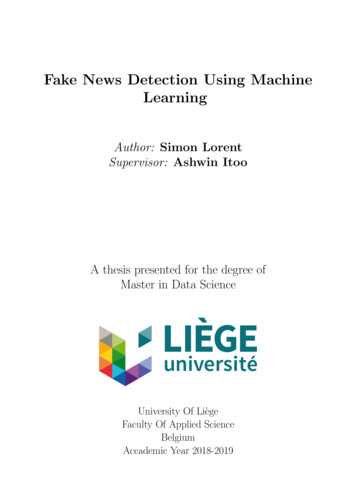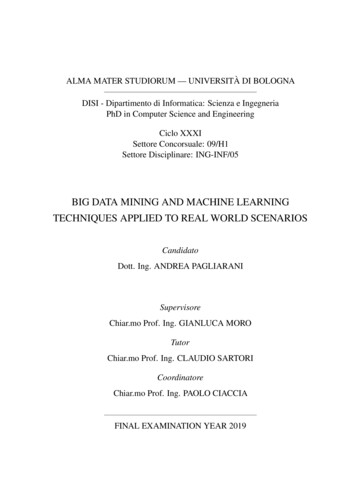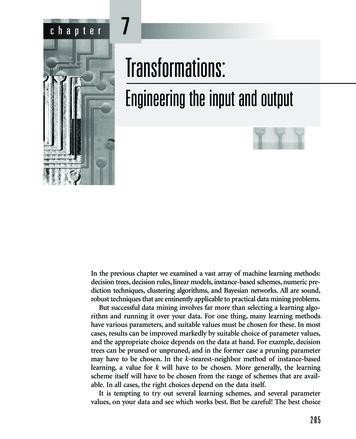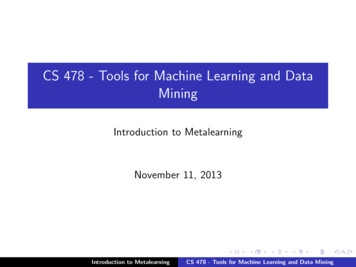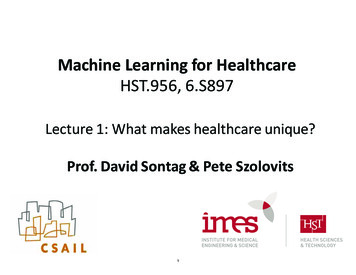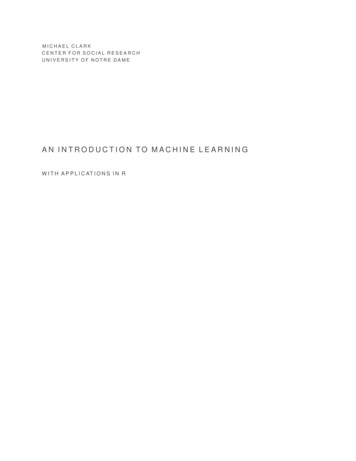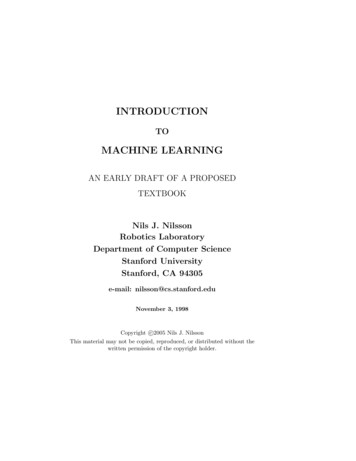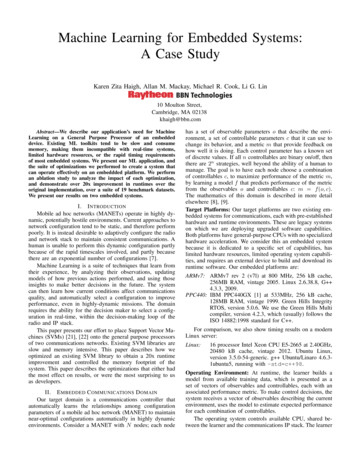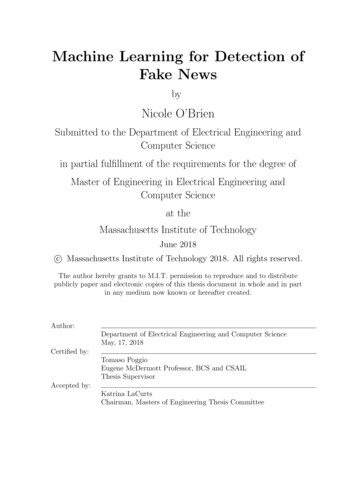
Transcription
Machine Learning for Detection ofFake NewsbyNicole O’BrienSubmitted to the Department of Electrical Engineering andComputer Sciencein partial fulfillment of the requirements for the degree ofMaster of Engineering in Electrical Engineering andComputer Scienceat theMassachusetts Institute of TechnologyJune 2018c Massachusetts Institute of Technology 2018. All rights reserved.The author hereby grants to M.I.T. permission to reproduce and to distributepublicly paper and electronic copies of this thesis document in whole and in partin any medium now known or hereafter created.Author:Department of Electrical Engineering and Computer ScienceMay, 17, 2018Certified by:Tomaso PoggioEugene McDermott Professor, BCS and CSAILThesis SupervisorAccepted by:Katrina LaCurtsChairman, Masters of Engineering Thesis Committee
Machine Learning for Detection of Fake Newsby Nicole O’BrienSubmitted to the Department of Electrical Engineering andComputer Science on May 1y, 2018, in partial fulfillment of therequirements for the degree of Masters of Engineering in ElectricalEngineering and Computer ScienceAbstractRecent political events have lead to an increase in the popularity and spread offake news. As demonstrated by the widespread effects of the large onset of fakenews, humans are inconsistent if not outright poor detectors of fake news. Withthis, efforts have been made to automate the process of fake news detection. Themost popular of such attempts include “blacklists” of sources and authors that areunreliable. While these tools are useful, in order to create a more complete end toend solution, we need to account for more difficult cases where reliable sources andauthors release fake news. As such, the goal of this project was to create a tool fordetecting the language patterns that characterize fake and real news through theuse of machine learning and natural language processing techniques. The results ofthis project demonstrate the ability for machine learning to be useful in this task.We have built a model that catches many intuitive indications of real and fake newsas well as an application that aids in the visualization of the classification decision.2
Contents1 Introduction82 Related Work112.1Spam Detection . . . . . . . . . . . . . . . . . . . . . . . . . . . . . . 112.2Stance Detection . . . . . . . . . . . . . . . . . . . . . . . . . . . . . 122.3Benchmark Dataset . . . . . . . . . . . . . . . . . . . . . . . . . . . . 133 Datasets143.1Sentence Level . . . . . . . . . . . . . . . . . . . . . . . . . . . . . . . 143.2Document Level . . . . . . . . . . . . . . . . . . . . . . . . . . . . . . 153.2.1Fake news samples . . . . . . . . . . . . . . . . . . . . . . . . 163.2.2Real news samples . . . . . . . . . . . . . . . . . . . . . . . . 174 Methods194.1Sentence-Level Baselines . . . . . . . . . . . . . . . . . . . . . . . . . 194.2Document-Level . . . . . . . . . . . . . . . . . . . . . . . . . . . . . . 204.2.1Tracking Important Trigrams . . . . . . . . . . . . . . . . . . 204.2.2Topic Dependency . . . . . . . . . . . . . . . . . . . . . . . . 244.2.3Cleaning . . . . . . . . . . . . . . . . . . . . . . . . . . . . . . 264.2.4Describing Neurons . . . . . . . . . . . . . . . . . . . . . . . . 285 Experimental Results305.1Tracking Important Trigrams . . . . . . . . . . . . . . . . . . . . . . 325.2Topic Dependency . . . . . . . . . . . . . . . . . . . . . . . . . . . . 325.3Cleaning . . . . . . . . . . . . . . . . . . . . . . . . . . . . . . . . . . 333
5.4Describing Neurons . . . . . . . . . . . . . . . . . . . . . . . . . . . . 356 Discussion376.1Tracking Important Neurons . . . . . . . . . . . . . . . . . . . . . . . 376.2Topic Dependency . . . . . . . . . . . . . . . . . . . . . . . . . . . . 396.3Cleaning . . . . . . . . . . . . . . . . . . . . . . . . . . . . . . . . . . 396.4Describing Neurons . . . . . . . . . . . . . . . . . . . . . . . . . . . . 407 Application418 Conclusion428.1Contributions . . . . . . . . . . . . . . . . . . . . . . . . . . . . . . . 428.2Future Work . . . . . . . . . . . . . . . . . . . . . . . . . . . . . . . . 439 Appendix454
List of Figures4.1Which trigrams might a human find indicative of real news? . . . . . 214.2Which trigrams might a human find indicative of fake news? . . . . . 214.3The output layer of the CNN where the higher value indicates thefinal classification of the text . . . . . . . . . . . . . . . . . . . . . . . 234.4Step 1: The Max Pool Values have the weighti activationi for eachof the neurons,i, detecting distinct patterns in the texts. These areaccumulated in the output layer. . . . . . . . . . . . . . . . . . . . . . 234.5Step 2: Find the index of the max pooled value from Step 1 in theconvolutional layer. . . . . . . . . . . . . . . . . . . . . . . . . . . . . 244.6Step 3: The index in convolutional layer found in Step 2 representswhich of the 998 trigrams caused the max pooled values from Step 1.Use that same index to find the corresponding trigram. . . . . . . . . 244.7Words exclusively common to one category (Fake/Real) . . . . . . . . 265.1Fake News Types, and their misclassification rates. . . . . . . . . . . 315.2The Guardian sections, and their misclassification rates.5.3The New York Times sections, and their misclassification rates. . . . 325.4Accuracies of evaluation using articles with each topic word. . . . . . 335.5Standard deviation of neuron weights with Cleaning. . . . . . . . . . 345.6Vocab Size with Cleaning. . . . . . . . . . . . . . . . . . . . . . . . . 355.7Accuracies with Cleaning. . . . . . . . . . . . . . . . . . . . . . . . . 359.1This shows the home page of the web application version of our Fake. . . . . . . 31News Detector as described in Section 7. . . . . . . . . . . . . . . . . 495
9.2This is the model from Cleaning Step 2, as described in Section 5.3,classifying an article from The Guardian. As you can see, the modelis very confident that the article is real news because of the “thiscontent” pattern at the end. . . . . . . . . . . . . . . . . . . . . . . . 509.3This is the model from Cleaning Step 2, as described in Section 5.3,classifying the same article from The Guardian Figure 9.2 withoutthe “this content” pattern. As you can see, the classification switchesby the removal of this pattern. Now, the model is very confidentthat the article is fake news because of the lack of the “this content”pattern at the end. . . . . . . . . . . . . . . . . . . . . . . . . . . . . 519.4This is the model from Cleaning Step 3, as described in 5.3 classifyingthe same article from The Guardian as Figure 9.3. As you cansee, this model picks up on new trigrams that are indicative of realnews and still classifies correctly, despite removal of the pattern whichcaused the Cleaning Step 2 model from Figure 9.4 to fail. . . . . . . 529.5This demonstrates an interesting correctly classified Fake News Articles. For real news trigrams, the model picks up a time reference,“past week“, and mathematical/technical phrases such as “analyzeatmospheres“, “the shape of” and “narrow spectral range“. However, these trigrams’ weights are obviously much smaller than theweights of the fake news trigrams about “aliens.“ . . . . . . . . . . . 539.6This demonstrates an interesting correctly classified Fake News Articles. For real news trigrams, the model picks up more mathematical/technical phrases such as “improvements in math scores”, “professionals” and “relatively large improvements“. The fake news trigramsseem to frequently involve “email messaging” and the abbreviate “et”.There does not seem to be anything obviously fake in this article, soits misclassification seems reasonable. . . . . . . . . . . . . . . . . . . 546
List of Tables3.1Sample Fake News Data from [1] . . . . . . . . . . . . . . . . . . . . 174.1Preliminary Baseline Results . . . . . . . . . . . . . . . . . . . . . . . 195.1Confusion matrix from our “best” model . . . . . . . . . . . . . . . . 305.2Target Word Distribution . . . . . . . . . . . . . . . . . . . . . . . . 335.3Neuron Descriptions and words most frequent in the trigrams thatcaused the highest activation - “All Words“ . . . . . . . . . . . . . . 365.4Neuron Descriptions and words most frequent in the trigrams thatcaused the highest activation - “Election“ . . . . . . . . . . . . . . . . 369.1Misclassified Fake News Articles, By Type. . . . . . . . . . . . . . . . 459.2Misclassified The Guardian articles, by section. This excludes sections that made up 1% of the total count of The Guardian Articlesand 1% of all misclassified The Guardian articles in our dataset. . . 469.3Misclassified New York Times articles, by section. This excludes sections that made up 1% of the total count of New York Times Articlesand 1% of all misclassified New York Times articles in our dataset.9.447The following table shows the words that were most common in theaggregation of trigrams detected as indicators of Real and Fake News,excluding those that were common to both. . . . . . . . . . . . . . . 487
Chapter 1IntroductionThe rise of fake news during the 2016 U.S. Presidential Election highlighted notonly the dangers of the effects of fake news but also the challenges presented whenattempting to separate fake news from real news. Fake news may be a relativelynew term but it is not necessarily a new phenomenon. Fake news has technicallybeen around at least since the appearance and popularity of one-sided, partisannewspapers in the 19th century. However, advances in technology and the spread ofnews through different types of media have increased the spread of fake news today.As such, the effects of fake news have increased exponentially in the recent past andsomething must be done to prevent this from continuing in the future.I have identified the three most prevalent motivations for writing fake newsand chosen only one as the target for this project as a means to narrow the searchin a meaningful way. The first motivation for writing fake news, which dates backto the 19th century one-sided party newspapers, is to influence public opinion. Thesecond, which requires more recent advances in technology, is the use of fake headlines as clickbait to raise money. The third motivation for writing fake news, whichis equally prominent yet arguably less dangerous, is satirical writing. [2] [3] Whileall three subsets of fake news, namely, (1) clickbait, (2), influential, and (3) satire,share the common thread of being fictitious, their widespread effects are vastlydifferent. As such, this paper will focus primarily on fake news as defined by politifact.com, “fabricated content that intentionally masquerades as news coverage ofactual events.” This definition excludes satire, which is intended to be humorous8
and not deceptive to readers. Most satirical articles come from sources like “TheOnion“, which specifically distinguish themselves as satire. Satire can already beclassified, by machine learning techniques according to [4]. Therefore, our goal is tomove beyond these achievements and use machine learning to classify, at least aswell as humans, more difficult discrepancies between real and fake news.The dangerous effects of fake news, as previously defined, are made clear byevents such as [5] in which a man attacked a pizzeria due to a widespread fake newsarticle. This story along with analysis from [6] provide evidence that humans arenot very good at detecting fake news, possibly not better than chance . As such,the question remains whether or not machines can do a better job.There are two methods by which machines could attempt to solve the fake newsproblem better than humans. The first is that machines are better at detecting andkeeping track of statistics than humans, for example it is easier for a machine todetect that the majority of verbs used are “suggests” and “implies” versus, “states”and “proves.” Additionally, machines may be more efficient in surveying a knowledgebase to find all relevant articles and answering based on those many different sources.Either of these methods could prove useful in detecting fake news, but we decided tofocus on how a machine can solve the fake news problem using supervised learningthat extracts features of the language and content only within the source in question,without utilizing any fact checker or knowledge base. For many fake news detectiontechniques, a “fake” article published by a trustworthy author through a trustworthysource would not be caught. This approach would combat those “false negative”classifications of fake news. In essence, the task would be equivalent to what ahuman faces when reading a hard copy of a newspaper article, without internetaccess or outside knowledge of the subject (versus reading something online wherehe can simply look up relevant sources). The machine, like the human in the coffeeshop, will have only access to the words in the article and must use strategies thatdo not rely on blacklists of authors and sources.The current project involves utilizing machine learning and natural languageprocessing techniques to create a model that can expose documents that are, with9
high probability, fake news articles. Many of the current automated approaches tothis problem are centered around a “blacklist” of authors and sources that are knownproducers of fake news. But, what about when the author is unknown or when fakenews is published through a generally reliable source? In these cases it is necessaryto rely simply on the content of the news article to make a decision on whetheror not it is fake. By collecting examples of both real and fake news and traininga model, it should be possible to classify fake news articles with a certain degreeof accuracy. The goal of this project is to find the effectiveness and limitations oflanguage-based techniques for detection of fake news through the use of machinelearning algorithms including but not limited to convolutional neural networks andrecurrent neural networks. The outcome of this project should determine how muchcan be achieved in this task by analyzing patterns contained in the text and blindto outside information about the world.This type of solution is not intended to be an end-to end solution for fake newsclassification. Like the “blacklist” approaches mentioned, there are cases in whichit fails and some for which it succeeds. Instead of being an end-to-end solution, thisproject is intended to be one tool that could be used to aid humans who are trying toclassify fake news. Alternatively, it could be one tool used in future applications thatintelligently combine multiple tools to create an end-to-end solution to automatingthe process of fake news classification.10
Chapter 2Related Work2.1Spam DetectionThe problem of detecting not-genuine sources of information through contentbased analysis is considered solvable at least in the domain of spam detection [7],spam detection utilizes statistical machine learning techniques to classify text (i.e.tweets [8] or emails) as spam or legitimate. These techniques involve pre-processingof the text, feature extraction (i.e. bag of words), and feature selection based onwhich features lead to the best performance on a test dataset. Once these featuresare obtained, they can be classified using Nave Bayes, Support Vector Machines,TF-IDF, or K-nearest neighbors classifiers. All of these classifiers are characteristicof supervised machine learning, meaning that they require some labeled data inorder to learn the function (as seen in [9]) Cspamf (message, θ) Cleg if classified as spam otherwisewhere, m is the message to be classified and is a vector of parameters and Cspamand Cleg are respectively spam and legitimate messages. The task of detecting fakenews is similar and almost analogous to the task of spam detection in that both aimto separate examples of legitimate text from examples of illegitimate, ill-intendedtexts. The question, then, is how can we apply similar techniques to fake newsdetection. Instead of filtering like we do with spam, it would be beneficial to be able11
to flag fake news articles so that readers can be warned that what they are readingis likely to be fake news. The purpose of this project is not to decide for the readerwhether or not the document is fake, but rather to alert them that they need to useextra scrutiny for some documents. Fake news detection, unlike spam detection, hasmany nuances that arent as easily detected by text analysis. For example, a humanactually needs to apply their knowledge of a particular subject in order to decidewhether or not the news is true. The “fakeness” of an article could be switched onor off simply by replacing one persons name with another persons name. Therefore,the best we can do from a content-based standpoint is to decide if it is somethingthat requires scrutiny. The idea would be for a reader to do leg work of researchingother articles on the topic to decide whether or not the article is actually fake, buta “flagging” would alert them to do so in appropriate circumstances.2.2Stance DetectionIn December of 2016, a group of volunteers from industry and academia starteda contest called the Fake News Challenge [10]. The goal of this contest was to encourage the development of tools that may help human fact checkers identify deliberatemisinformation in news stories through the use of machine learning, natural languageprocessing and artificial intelligence. The organizers decided that the first step inthis overarching goal was understanding what other news organizations are sayingabout the topic in question. As such, they decided that stage one of their contestwould be a stance detection competition. More specifically, the organizers built adataset of headlines and bodies of text and challenged competitors to build classifiers that could correctly label the stance of a body text, relative to a given headline,into one of four categories: “agree”, “disagree”, “discusses” or “unrelated.” The topthree teams all reached over 80% accuracy on the test set for this task. The topteams model was based on a weighted average between gradient-boosted decisiontrees and a deep convolutional neural network.12
2.3Benchmark Dataset[11] demonstrates previous work on fake news detection that is more directlyrelated to our goal of using a text-only approach to make a classification. Theauthors not only create a new benchmark dataset of statements (see Section 3.1 ),but also show that significant improvements can be made in fine-grained fake newsdetection by using meta-data (i.e. speaker, party, etc) to augment the informationprovided by the text.13
Chapter 3DatasetsThe lack of manually labeled fake news datasets is certainly a bottleneck foradvancing computationally intensive, text-based models that cover a wide array oftopics. The dataset for the fake news challenge does not suit our purpose due tothe fact that it contains the ground truth regarding the relationships between textsbut not whether or not those texts are actually true or false statements. For ourpurpose, we need a set of news articles that is directly classified into categories ofnews types (i.e. real vs. fake or real vs parody vs. clickbait vs. propaganda). Formore simple and common NLP classification tasks, such as sentiment analysis, thereis an abundance of labeled data from a variety of sources including Twitter, AmazonReviews, and IMDb Reviews. Unfortunately, the same is not true for finding labeledarticles of fake and real news. This presents a challenge to researchers and data scientists who want to explore the topic by implementing supervised machine learningtechniques. I have researched the available datasets for sentence-level classificationand ways to combine datasets to create full sets with positive and negative examplesfor document-level classification.3.1Sentence Level[11] produced a new benchmark dataset for fake news detection that includes12,800 manually labeled short statements on a variety of topics. These statementscome from politifact.com, which provides heavy analysis of and links to the source14
documents for each of the statements. The labels for this data are not true andfalse but rather reflect the “sliding scale” of false news and have 6 intervals oflabels. These labels, in order of ascending truthfulness, include ’pants-fire’, ’false’,barely true, ’half-true’, ’mostly-true’, and true. The creators of this database ranbaselines such as Logistic Regression, Support Vector Machines, LSTM, CNN and anaugmented CNN that used metadata. They reached 27% accuracy on this multiclassclassification task with the CNN that involved metadata such as speaker and partyrelated to the text.3.2Document LevelThere exists no dataset of similar quality to the Liar Dataset for document-level classification of fake news. As such, I had the option of using the headlinesof documents as statements or creating a hybrid dataset of labeled fake and legitimate news articles. [12] shows an informal and exploratory analysis carried out bycombining two datasets that individually contain positive and negative fake newsexamples. Genes trains a model on a specific subset of both the Kaggle datasetand the data from NYT and the Guardian. In his experiment, the topics involvedin training and testing are restricted to U.S News, Politics, Business and Worldnews. However, he does not account for the difference in date range between thetwo datasets, which likely adds an additional layer of topic bias based on topics thatare more or less popular during specific periods of time.We have collected data in a manner similar to that of Genes [12], but morecautious in that we control for more bias in the sources and topics. Because the goalof our project was to find patterns in the language that are indicative of real or fakenews, having source bias would be detrimental to our purpose. Including any sourcebias in our dataset, i.e. patterns that are specific to NYT, The Guardian, or anyof the fake news websites, would allow the model to learn to associate sources withreal/fake news labels. Learning to classify sources as fake or real news is an easyproblem, but learning to classify specific types of language and language patternsas fake or real news is not. As such, we were very careful to remove as much of15
the source-specific patterns as possible to force our model to learn something moremeaningful and generalizable.We admit that there are certainly instances of fake news in the New York Timesand probably instances of real news in the Kaggle dataset because it is based on alist of unreliable websites. However, because these instances are the exception andnot the rule, we expect that the model will learn from the majority of articles thatare consistent with the label of the source. Additionally, we are not trying to train amodel to learn facts but rather learn deliveries. To be more clear, the deliveries andreporting mechanisms found in fake news articles within New York Times shouldstill possess characteristics more commonly found in real news, although they willcontain fictitious factual information.3.2.1Fake news samples[1] contains a dataset of fake news articles that was gathered by using a toolcalled the BS detector ([13] which essentially has a blacklist of websites that aresources of fake news. The articles were all published in the 30 days between October,26 2016 to November 25, 2016. While any span of dates would be characterized bythe current events of that time, this range of dates is particularly interesting becauseit spans the time directly before, during, and directly after the 2016 election. Thedataset has articles and metadata from 244 different websites, which is helpful inthe sense that the variety of sources will help the model to not learn a source bias.However, at a first glance of the dataset, you can easily tell that there are still certainobvious reasons that a model could learn specifics of what is included in the “body”text in this dataset. For example, there are instances of the author and source inthe body text, as seen in Section 3.1. Also, there are some patterns like includingthe date that, if not also repeated in the real news dataset, could be learned by themodel.16
Table 3.1: Sample Fake News Data from [1]AuthorAlex AnsarySourceDateamtvmedia.com2016-11-02TitleChina Airport Security Robot GivesElectroshocksAaron Bandlerdailywire.com 2016-11-11Poll: Sexism WasNOT A Factor InHillary’s Loss DailyWireTextChina Airport Security Robot GivesElectroshocks11/02/2016ACTIVISTPOSTWhile debate surrounds the threatof .Poll: Sexism WasNOT A FactorInHillary’s Loss By:AaronBandlerNovember 11, 2016Some leftists stillreeling from HillaryClinton’s stunningdefeat.All of these sources and authors are repeated in the dataset. Additionally, thepresence of the date/title could be an easy cue that a text came from this dataset ifthe real news dataset did not contain this metadata. As such, the model could easilylearn the particulars of this dataset and not learn anything about real/fake newsitself in order to best classify the data. To avoid this, we removed the author, source,date, title, and anything that appeared before these segments.The datasetalso contained a decent amount of repetitive data and incomplete data, we removedany non-unique samples and also simples that appeared incomplete (i.e. lacked asource). This left us with approximately 12,000 samples of fake news.Sincethe Kaggle dataset does not contain positive examples, i.e. examples of real news, itis necessary to augment the dataset with such in order to either compare or performsupervised learning.3.2.2Real news samplesAs suggested by [12] , an acceptable approach would be to use the APIs fromreliable sources like New York Times and The Guardian. The NYT API providessimilar information to that of the kaggle dataset, including both text and imagesthat are found in the document. The Kaggle Dataset also provides the source ofeach article, which is trivial for the APIs of specific newspaper sources.17We
pulled articles from both of these sources in the same range of dates that the fakenews was restricted to (October 26 , 2016 to November 25, 2016). This is importantbecause of the specificity of the current events at that time - information that wouldnot likely be present in news outside of this timeframe. There were just over 9,000Guardian articles and just over 2,000 New York Times articles. Unlike the Kaggledataset, which had 244 different websites as sources, our real news dataset onlyhas two different source: The New York Times and The Guardian. Due to thisdifference, we found that extra effort was required to ensure that we removed anysource-specific patterns so that the model would not simply learn to identify how anarticle from the New York Times is written or how an article from The Guardian iswritten. Instead, we wanted our model to learn more meaningful language patternsthat are similar to real news reporting, regardless of the source.18
Chapter 4Methods4.1Sentence-Level BaselinesI have run the baselines described in [11], namely multi-class classificationdone via logistic regression and support vector machines. The features used weren-grams and TF-IDF. N-grams are consecutive groups of words, up to size “n”.For example, bi-grams are pairs of words seen next to each other. Features for asentence or phrase are created from n-grams by having a vector that is the lengthof the new “vocabulary set,” i.e. it has a spot for each unique n-gram that receivesa 0 or 1 based on whether or not that n-gram is present in the sentence or phrasein question. TF-IDF stands for term frequency inverse document frequency. It isa statistical measure used to evaluate how important a word is to a document in acollection or corpus. As a feature, TF-IDF can be used for stop-word filtering, i.e.discounting the value of words like “and,”, “the”, etc. whose counts likely have noeffect on the classification of the text. An alternative approach is removing stopwords (as defined in various packages, such as Pythons NLTK). The results for thispreliminary evaluation are found in Table 4.1Table 4.1: Preliminary Baseline ResultsModelLogistic RegressionLogistic RegressionSVM w. Linear KernelSVM w. RBF kernelVectorizerBag of WordsTF-IDFBag of WordsBag of WordsN-gram Range1-41-41119Penalty, C0.0110101000Dev Score0.25860.25160.25080.2492
Additionally, we explored some of the characteristic n-grams that may influenceLogistic Regression and other classifiers. In calculating the most frequent n-gramsfor “pants-fire” phrases and those of “true” phrases, we found that the word “wants”more frequently appears in “pants-fire” (i.e. fake news) phrases and the phrase“states” more frequently appears in “true” (i.e. real news) phrases. Intuitively,This makes sense because it is easier to lie about what a politician wants than tolie about what he or she has stated since the former is more difficult to confirm.This observation motivates the experiments in Section 4.2, which aim to find a morefull set of similarly intuitive patterns in the body texts of fake news and real newsarticles.4.2Document-LevelDeep neural networks have shown promising results in NLP for other classi-fication tasks such as [14]. CNNs are well suited for picking up multiple patterns,and sentences do not provide enough data for this to be useful. However, a CNNbaseline modeled off of the one described for NLP in [15] did not show a large improvement in accuracy on this task using the Liar Dataset. This is due to the lackof context provided in sentences. Not surprisingly, the same CNN performance onthe full body text datasets we created was much higher.4.2.1Tracking Important TrigramsThe nature of this project was to decide if and how machine learning couldbe useful in detecting patterns characteristic of real and fake news articles. Inaccordance with this purpose,
use of machine learning and natural language processing techniques. The results of this project demonstrate the ability for machine learning to be useful in this task. We have built a model that catches many intuitive indications of real and fake news as well as an application that a
